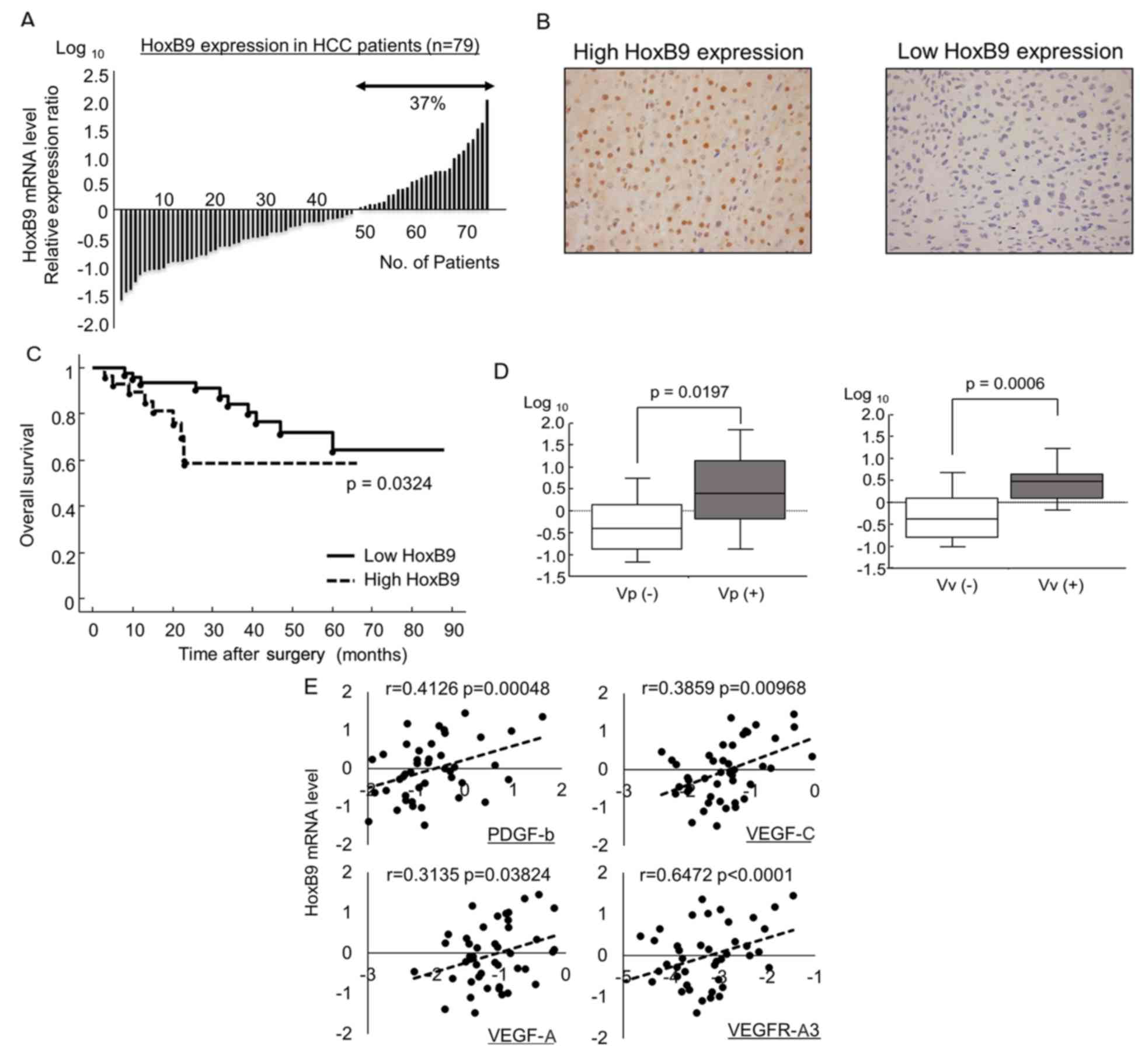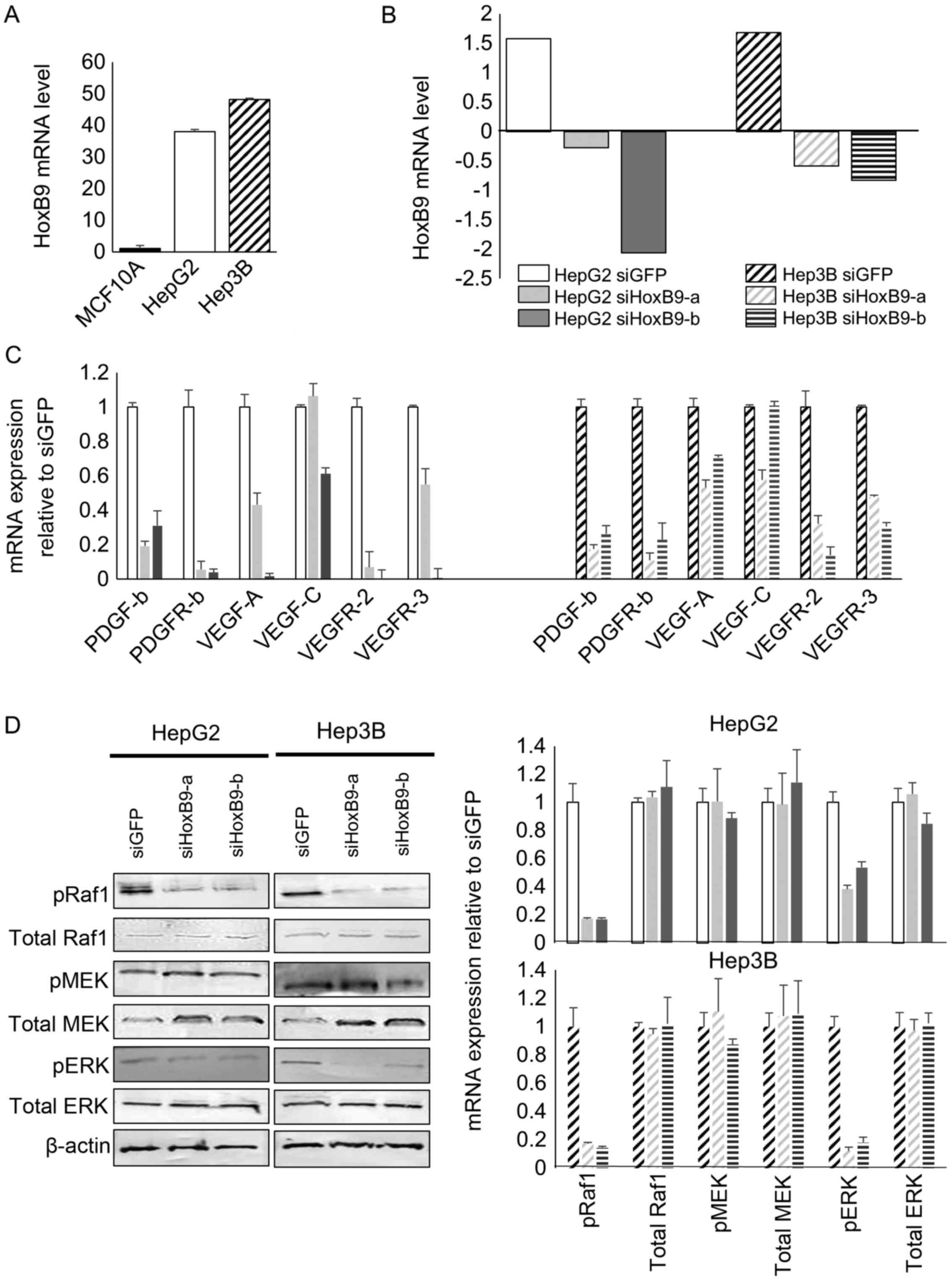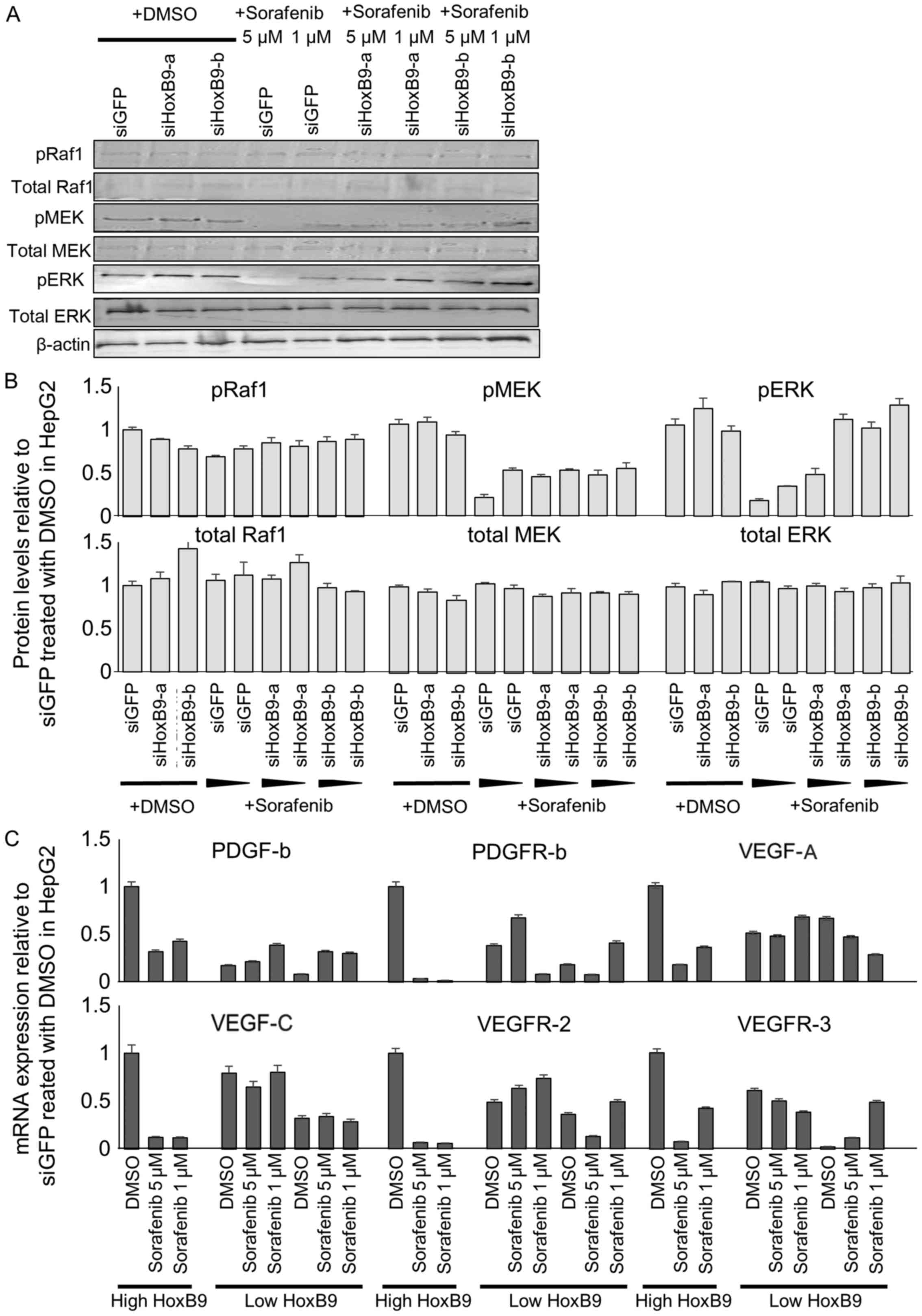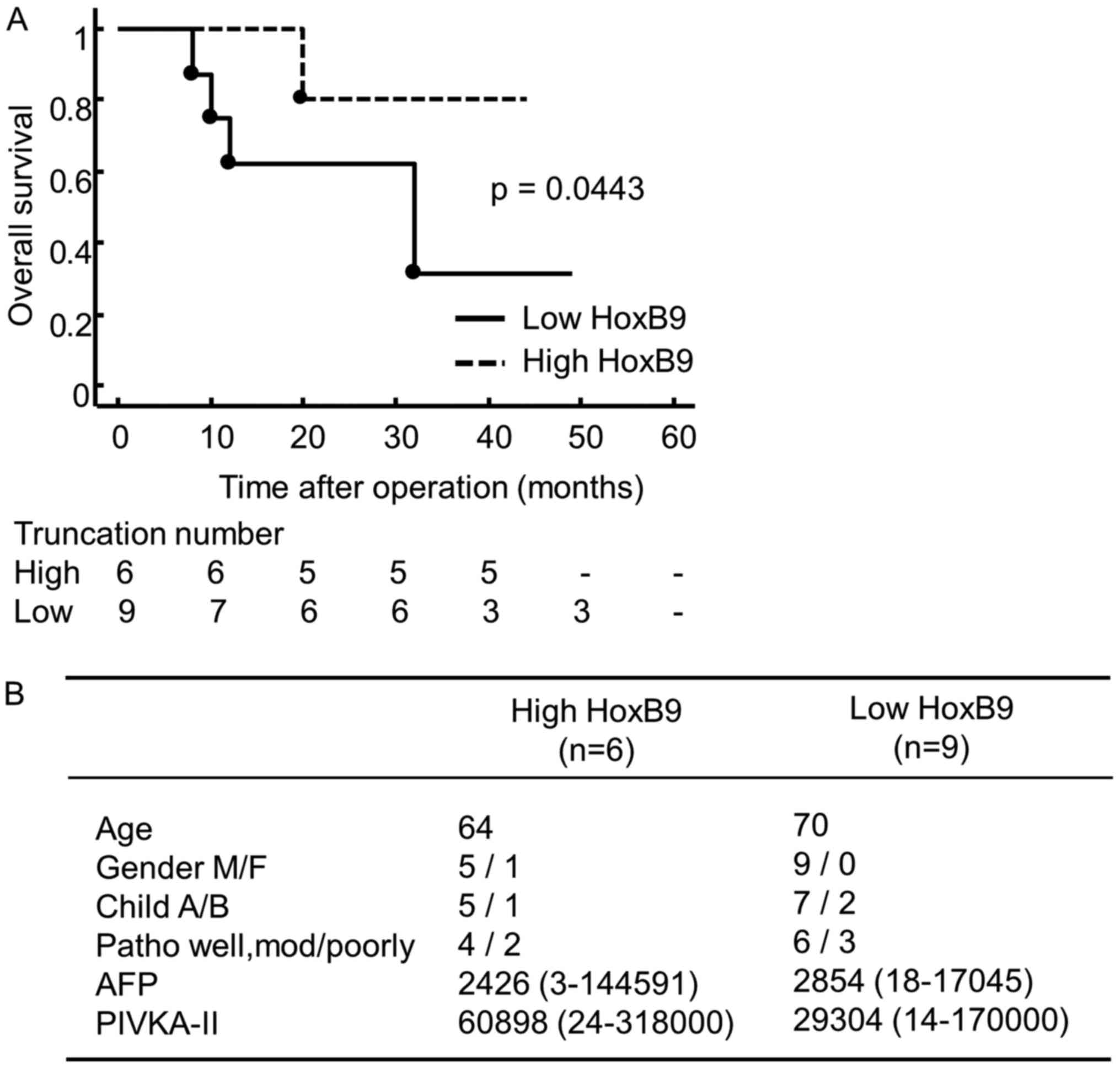Increased expression of HOXB9 in hepatocellular carcinoma predicts poor overall survival but a beneficial response to sorafenib
- Authors:
- Published online on: February 23, 2017 https://doi.org/10.3892/or.2017.5474
- Pages: 2270-2276
Abstract
Introduction
HOXB9, a member of the class I homeobox (HOX) genes, regulates several cellular processes, including angiogenesis and maintenance of cell fate (1). It is overexpressed in human breast cancer and its expression is associated with increased tumorigenicity, lung metastasis and radioresistance (2,3). HOXB9 transactivates several angiogenic factors as well as erythroblastic leukemia viral oncogene homolog (ErbB) and TGF-β ligands leading to epithelial-mesenchymal transition (EMT), increased angiogenesis and distal metastasis. In particular, HOXB9 induces tumor proliferation and metastasis by activating angiogenesis; however, little is known concerning the relationship between HOXB9 expression and angiogenesis in hepatocellular carcinoma (HCC).
HCC is considered a serious public health concern particularly in endemic areas of hepatitis B or C viral infection, including Africa and Southeast Asia (4), despite recent progress in surgical and non-surgical treatment including multikinase inhibitor therapy.
The prognosis for HCC patients is still dismal, since the disease is discovered at an advanced stage in a substantial number of patients when curative therapy is no longer possible (5). Curative treatments (e.g., resection, transplantation or local ablation) are available only to patients with early-stage disease, however they are limited by high recurrence rates, impairing patient outcomes. At advanced stages, the multikinase inhibitor sorafenib is the only effective treatment, although vigorous efforts are underway to better characterize the molecular pathogenesis of liver cancer to refine the efficacy of other molecular-targeted therapies (6).
Sorafenib (Nexavar®; Bayer HealthCare Pharmaceuticals, Montville, NJ, USA) is an oral multikinase inhibitor that inhibits the serine-threonine kinases Raf-1 and B-Raf, the receptor tyrosine kinase activity of vascular endothelial growth factor (VEGF) receptors 1-3, and platelet-derived growth factor receptor β (7). It blocks tumor cell proliferation and tumor angiogenesis, and increases the rate of apoptosis in a wide range of tumor models by targeting the Raf/mitogen-activated protein kinase/extracellular signal-regulated kinase (RAF/MEK/ERK) and VEGF signaling pathways. Therefore, identification of accurate prognostic biomarkers to distinguish patients at high risk of recurrence or metastasis and surrogate markers for non-surgical therapy is of the utmost importance for developing preventive strategies to improve the outcome of HCC patients.
In the present study, we demonstrated that increased expression of HOXB9 in HCC is associated with the induction of angiogenic factors, increased vascular invasion and poor overall survival of these patients. Sorafenib treatment was found to suppress the expression of angiogenic factors and the Raf/MEF/ERK pathway in HOXB9-expressing cells in vitro, and HCC patients with increased HOXB9 expression exhibited increased overall survival upon treatment with sorafenib. Collectively, these results suggest that HOXB9 expression in HCC could be a surrogate marker for a beneficial response to sorafenib treatment.
Materials and methods
Cell lines and cell culture
The human HCC cell lines, HepG2 and Hep3B, were obtained from the American Type Culture Collection (ATCC; Manassas, VA, USA). The identity of all cells was independently authenticated by short tandem repeat genotyping in May 2014. The cells were cultured in Dulbecco's modified Eagle's medium (DMEM), supplemented with 10% bovine fetal serum, 100 U/ml penicillin, 100 µg/ml streptomycin, 1X non-essential amino acids and 1 mM sodium pyruvate, and incubated in humidified 37̊C incubators with 5% CO2. Chemically synthesized Stealth RNAi™ siRNAs were purchased from Invitrogen (Carlsbad, CA, USA) and were used to knock down endogenous HOXB9 expression in HCC cells. Two different siRNAs were individually transfected into the cells at a final concentration of 100 nM using Lipofectamine RNAiMAX (Invitrogen). In addition, siGFP was used as a control siRNA.
Ethical approval, consent to participate and consent of publication
The present study was approved by the Ethics Committee of Tokyo Medical University. The patients provided consent for their participation and the publication of the present study.
mRNA expression
Our analysis included 79 HCC patients who underwent consecutive resection between September 2008 and December 2014 at Tokyo Medical University Hachioji Medical Center. All protocols were performed in accordance with the Ethics Committee of Tokyo Medical University. Consecutive frozen tissue specimens containing cancerous and matched normal hepatocyte regions were available from HCC patients (who received a pathological diagnosis) to assess gene panels by quantitative reverse-transcription PCR (qRT-PCR). HOXB9 mRNA expression was examined in cancer and in normal hepatocytes derived from consecutive samples of patients who had undergone surgery at our institute during 2008–2014. The expression ratios (cancer to normal hepatocytes surrounded by cancer) were examined using qRT-PCR. RNA was extracted from cells using the RNeasy kit (Qiagen, Valencia, CA, USA). Conditions for semi-quantitative amplification of cDNA were 95̊C for 2 min, followed by 25 cycles of 95̊C for 30 sec, 56̊C for 30 sec, and 72̊C for 60 sec, with a final extension cycle at 72̊C for 10 min. RT-PCR analysis was run in triplicate for each sample on a Light Cycler 480 Real-Time PCR System using SYBR-Green I Master Mix (Roche, Mannheim, Germany). The following program was run: pre-incubation for 5 min at 95̊C, amplification for 45 cycles (10 sec of denaturation at 95̊C, 10 sec of annealing at 57̊C and a 10-sec extension at 72̊C), with melting curve analysis. mRNA levels of the target genes were normalized against mRNA levels of GAPDH, which was used as an internal control. The sequences of all the primers used are listed as follows: HoxB9 forward, 5′CACCATGTCCATTTCTGGGACGCTTAG3′ and reverse, 5′AAACTCTTTGCCCTGCTCCTTATTC3′; GAPDH forward, 5′ATCATCCCTGCCTCTACTGG3′ and reverse, 5′TTTCTAGACCGGCAGGTCAGGT3′; PDGF-b forward, 5′GATCCGCTCCTTTGATGATC3′ and reverse, 5′GTCTCACACTTGCATGCCAG3′; PDGFR-b forward, 5′AATGTCTCCAGCACCTTCGT3′ and reverse, 5′AGCGGA TGTGGTAAGGCATA3′; VEGF-A forward, 5′ACCATGCCA AGTGGTCCCAG3′ and reverse, 5′CTTTCTTTGGTCTGCA TTCACA3′; VEGF-C forward, 5′CTTCTTTAAACCTCCATG TGTGTC3′ and reverse, 5′GAATGAACTTGTCTGTAAACA TCCA3′; VEGFR-2 forward, 5′TCATCTGTTACAGCTTCC AAGT3′ and reverse, 5′GGTTTGATTCTTTCCAGGCTC3′; VEGFR-3 forward, 5′CCAGCATCGTGTGGTACAAAGA3′ and reverse, 5′CTCCCCGGGGTCCATGATGAT3′.
Western blotting and immunohistochemistry
Protein expression was detected by western blotting using antibodies against HOXB9 and pERK (phospho-ERK) (Santa Cruz Biotechnology, Santa Cruz, CA, USA); ERK2, pMEK (phospho-MEK) and MEK1 (Cell Signaling Technology, Beverly, MA, USA); and pRAF1, Raf1 and actin (Abcam, Cambridge, MA, USA). The western blotting protocols used have been previously described (8). Immunohistochemistry (IHC) was carried out on 5-µm sections of formalin-fixed paraffin-embedded (FFPE) tissue by heat-induced epitope retrieval in 10 mmol/l sodium citrate (pH 6.0) before blocking with 5% BSA-PBS. For IHC, HOXB9 expression was detected using the anti-human HOXB9-specific antibody at a dilution of 1:250 (Santa Cruz Biotechnology).
Sorafenib treatment
Cells were plated into 12- to 24-well tissue culture plates or 10-cm2 dishes and cultured overnight. Sorafenib (LC Laboratories, Woburn, MA, USA) was added to the cells at two different concentrations (5 and 1 µM) for 48 h before mRNA and protein extraction. The final dimethyl sulfoxide (DMSO) concentration in all experiments was <0.05%. A total of 15 patients with tumor-node-metastasis (TNM) stage III HCC were treated with sorafenib after curative resection.
Statistical analyses
Data represent the mean ± standard error of the mean. Comparisons between groups were made using a two-tailed t-test or U test for continuous variables, and Fishers exact test for comparison of proportions. Correlations were assessed with the non-parametric Spearman's coefficient. All calculations were carried out with the SPSS software package (SPSS 18.0). Overall survival (OS) curves were drawn according to Kaplan-Meier estimates and compared by log-rank tests. P<0.05 was defined as significant.
Results
HOXB9 expression in HCC
To investigate HOXB9 expression in HCC, we examined samples from 79 HCC patients who received curative resection at our institute. HOXB9 mRNA was expressed in ~40% of the patients (Fig. 1A) and was upregulated in tumors relative to uninvolved adjacent normal hepatocytes as determined by both qRT-PCR and immunohistochemical staining (Fig. 1B). Although, HOXB9 expression in HCC did not affect disease-free survival after surgery (data not shown), increased HOXB9 expression in HCC was significantly associated with a poor prognosis in OS (5-year OS rate; 63.5 vs. 58.5%; p=0.0324) (Fig. 1C), as previously reported for breast and colorectal cancer (9,10). Moreover, HOXB9 mRNA expression was significantly higher in patients exhibiting vascular invasion (both portal and hepatic vein) compared to those who were negative for vascular invasion (Fig. 1D). A significant positive correlation was observed between HOXB9 mRNA expression and several angiogenic factors targeted by sorafenib: PDGF-b, VEGF-C, VEGF-C and VEGFR-A3 (p<0.05) (Fig. 1E) (11).
HOXB9 regulates the expression of angiogenic factors and Raf/MEK/ERK signaling
HCC cell lines, HepG2 and Hep3B, showed high HOXB9 mRNA expression relative to the human mammary epithelial cell line, MCF10A, which showed low HOXB9 mRNA (Fig. 2A) as previously reported (2). To determine the effect of the loss of HOXB9 in HCC cells, we depleted HOXB9 mRNA in these cells using two short interfering RNA (siRNA) oligonucleotides (Invitrogen) targeting HOXB9. Both siRNAs decreased HOXB9 expression in the HCC cells by −130 and −230% (Fig. 2B). A decrease in HOXB9 expression by these siRNAs also decreased the expression of several angiogenic factors. These angiogenic factors which are targeted by sorafenib were highly expressed in the siGFP-transfected control HepG2 and Hep3B lines (Fig. 2C). These results are consistent with previously reported results in breast cancer (2,10). Moreover, a decrease in HOXB9 expression in the two HCC cell lines also mitigated the Raf/MEK/ERK pathway (Fig. 2D), which is targeted by sorafenib1 (2). Knockdown of HOXB9 expression led to a decrease in phospho(p)Raf and pERK. The quantification of these western blotting bands are shown (Fig. 2D, right panel).
Significance of HOXB9 expression on sorafenib response
To determine whether sorafenib, the multikinase inhibitor suppresses the Raf/MEK/ERK pathway upregulated in HOXB9-expressing cells, we treated the cells transfected with siGFP and siHOXB9 (expressing high or low HOXB9, respectively) with 1 and 5 µM of sorafenib. The proteins of the Raf/MEK/ERK pathway were more markedly suppressed in the cells expressing high levels of HOXB9 compared to those expressing low HOXB9 mRNA (Fig. 3A). The quantification of these western blotting bands is shown (Fig. 3B).
We similarly determined whether sorafenib treatment suppresses the expression of HOXB9-regulating angiogenic factors in cells expressing high and low HOXB9. Sorafenib potently suppressed the expression of several angiogenic factors by 60–95% in cells expressing high HOXB9 cells compared to the levels in cells expressing low levels of HOXB9 (−50 and −10%) (Fig. 3C). Collectively these results show that HOXB9-expressing cells, by expressing higher baseline levels of angiogenic factors and activation of the Raf/MEK/ERK pathway, are more likely to be responsive to sorafenib treatment.
To clarify the clinical significance of these findings, we conducted a retrospective study in HCC patients who underwent resection before treatment with sorafenib at our institute between 2008 and 2012 (n=15). Samples obtained from patients before chemotherapy were analyzed by qRT-PCR. The demographic and clinical data showed no significant differences with regard to age, gender, pathological stage or chemotherapy between groups with high and low expression of HOXB9. High expression of HOXB9 mRNA was associated with longer OS after treatment with sorafenib (3-years OS rate; 80 vs. 30%, p=0.0443) compared with patients expressing low levels of HOXB9 (Fig. 4A). In addition, clinical findings among the two groups had no significant difference (Fig. 4B).
Discussion
HOXB9 has been reported to be overexpressed in neoplastic tissues (13). HOXB9 promotes the expression of angiogenic factors, as well as ErbB and TGF-β ligands. From a biological perspective, multiple HOX-binding sites are present in the promoters of angiopoietin-like 2, IL-8, TGF-β2, VEGF and bFGF. AREG, ERG, VEGF and bFGF are direct targets of HOXB9-induced transcriptional activation (14,15). In the present study, we demonstrated that HOXB9 promoted the expression of angiogenic factors and the Raf/MEK/ERK pathway in HCC. Both angiogenesis and signaling through the RAF/MEK/ERK cascade play critical roles in the development of HCC and may lead to increased tumorigenesis and poor overall survival in HCC patients.
Sorafenib is a multikinase inhibitor with activity against the Ser/Thr kinase Raf, known to be important in tumor cell signaling and tumor cell proliferation, and in the regulation of several receptor tyrosine kinases involved in angiogenesis, including VEGFR-2 and PDGFR-12. Although the HOXB9 gene has not been described as a direct target of sorafenib, its ability to induce angiogenesis may render HOXB9-expressing HCC cells sensitive to sorafenib. This is consistent with our data showing increased overall survival of HOXB9-overexpressing HCC patients treated with sorafenib. There is increasing evidence of the potential crosstalk between, for example, HOXB9 and wingless/T-cell factor (Wnt/TCF) signaling pathways (16). Expression profiling of HCC patients treated with sorafenib may shed light on potential correlations between HOXB9-related molecular classes and treatment responses.
Surrogate biomarkers that predict the biological and clinical efficacy of sorafenib may help tailor treatment on an individual patient basis. The predictive value of the Raf/MEK/ERK signaling activity for the efficacy of sorafenib in HCC remains uncertain (17,18). In the present study, we found a strong correlation between increased HOXB9 activity in HCC and poor prognosis, but better therapeutic responses to sorafenib. Evaluation of HOXB9 activity in HCC can be useful to differentiate between responders and non-responders before commencing sorafenib treatment and to help select patients who are likely to benefit from the treatment. However, the present study, was based on a retrospective analysis of a small number of patients at a single site, and selection of patients for sorafenib treatment was subjective. The clinical significance of HOXB9 must therefore be addressed in a prospectively planned multicenter trial. Multigene assays involving a large number of specimens before and after sorafenib exposure may provide more reliable insights into tumor biology and the response to sorafenib treatment.
Acknowledgements
We thank Dr Shyamala Meheswaran (Cancer Center, Massachusetts General Hospital and Harvard Medical School) for the critical reading of the manuscript. This research was funded by a JSPS KAKENHI Grant-in-Aid for Young Scientists (B) (no. 25861217) and by the Tokyo Medical University Cancer Research Foundation.
Glossary
Abbreviations
Abbreviations:
|
HOXB9 |
homeobox B9 |
|
HOX |
homeobox |
|
VEGF |
vascular endothelial growth factor |
|
OS |
overall survival |
|
siRNA |
short interference RNA |
|
qRT-PCR |
quantitative reverse transcription-polymerase chain reaction |
References
|
Cantile M, Schiavo G, Terracciano L and Cillo C: Homeobox genes in normal and abnormal vasculogenesis. Nutr Metab Cardiovasc Dis. 18:651–658. 2008. View Article : Google Scholar : PubMed/NCBI | |
|
Hayashida T, Takahashi F, Chiba N, Brachtel E, Takahashi M, Godin-Heymann N, Gross KW, Vivanco M, Wijendran V, Shioda T, et al: HOXB9, a gene overexpressed in breast cancer, promotes tumorigenicity and lung metastasis. Proc Natl Acad Sci USA. 107:1100–1105. 2010. View Article : Google Scholar : PubMed/NCBI | |
|
Chiba N, Comaills V, Shiotani B, Takahashi F, Shimada T, Tajima K, Winokur D, Hayashida T, Willers H, Brachtel E, et al: Homeobox B9 induces epithelial-to-mesenchymal transition-associated radioresistance by accelerating DNA damage responses. Proc Natl Acad Sci USA. 109:2760–2765. 2012. View Article : Google Scholar : PubMed/NCBI | |
|
Sherman M: Hepatocellular carcinoma: Epidemiology, surveillance, and diagnosis. Semin Liver Dis. 30:3–16. 2010. View Article : Google Scholar : PubMed/NCBI | |
|
Rampone B, Schiavone B, Martino A, Viviano C and Confuorto G: Current management strategy of hepatocellular carcinoma. World J Gastroenterol. 15:3210–3216. 2009. View Article : Google Scholar : PubMed/NCBI | |
|
Llovet JM, Ricci S, Mazzaferro V, Hilgard P, Gane E, Blanc JF, de Oliveira AC, Santoro A, Raoul JL, Forner A, et al: SHARP Investigators Study Group: Sorafenib in advanced hepatocellular carcinoma. N Engl J Med. 359:378–390. 2008. View Article : Google Scholar : PubMed/NCBI | |
|
Wilhelm SM, Carter C, Tang L, Wilkie D, McNabola A, Rong H, Chen C, Zhang X, Vincent P, McHugh M, et al: BAY 43–9006 exhibits broad spectrum oral antitumor activity and targets the RAF/MEK/ERK pathway and receptor tyrosine kinases involved in tumor progression and angiogenesis. Cancer Res. 64:7099–7109. 2004. View Article : Google Scholar : PubMed/NCBI | |
|
Ha TU, Segev DL, Barbie D, Masiakos PT, Tran TT, Dombkowski D, Glander M, Clarke TR, Lorenzo HK, Donahoe PK, et al: Mullerian inhibiting substance inhibits ovarian cell growth through an Rb-independent mechanism. J Biol Chem. 275:37101–37109. 2000. View Article : Google Scholar : PubMed/NCBI | |
|
Seki H, Hayashida T, Jinno H, Hirose S, Sakata M, Takahashi M, Maheswaran S, Mukai M and Kitagawa Y: HOXB9 expression promoting tumor cell proliferation and angiogenesis is associated with clinical outcomes in breast cancer patients. Ann Surg Oncol. 19:1831–1840. 2012. View Article : Google Scholar : PubMed/NCBI | |
|
Hoshino Y, Hayashida T, Hirata A, Takahashi H, Chiba N, Ohmura M, Wakui M, Jinno H, Hasegawa H, Maheswaran S, et al: Bevacizumab terminates homeobox B9-induced tumor proliferation by silencing microenvironmental communication. Mol Cancer. 13:102–108. 2014. View Article : Google Scholar : PubMed/NCBI | |
|
Wilhelm SM, Adnane L, Newell P, Villanueva A, Llovet JM and Lynch M: Preclinical overview of sorafenib, a multikinase inhibitor that targets both Raf and VEGF and PDGF receptor tyrosine kinase signaling. Mol Cancer Ther. 7:3129–3140. 2008. View Article : Google Scholar : PubMed/NCBI | |
|
Liu L, Cao Y, Chen C, Zhang X, McNabola A, Wilkie D, Wilhelm S, Lynch M and Carter C: Sorafenib blocks the RAF/MEK/ERK pathway, inhibits tumor angiogenesis, and induces tumor cell apoptosis in hepatocellular carcinoma model PLC/PRF/5. Cancer Res. 66:11851–11858. 2006. View Article : Google Scholar : PubMed/NCBI | |
|
Abate-Shen C: Deregulated homeobox gene expression in cancer: Cause or consequence? Nat Rev Cancer. 2:777–785. 2002. View Article : Google Scholar : PubMed/NCBI | |
|
Jain RK: Molecular regulation of vessel maturation. Nat Med. 9:685–693. 2003. View Article : Google Scholar : PubMed/NCBI | |
|
Shrestha B, Ansari KI, Bhan A, Kasiri S, Hussain I and Mandal SS: Homeodomain-containing protein HOXB9 regulates expression of growth and angiogenic factors, facilitates tumor growth in vitro and is overexpressed in breast cancer tissue. FEBS J. 279:3715–3726. 2012. View Article : Google Scholar : PubMed/NCBI | |
|
Nguyen DX, Chiang AC, Zhang XH, Kim JY, Kris MG, Ladanyi M, Gerald WL and Massagué J: WNT/TCF signaling through LEF1 and HOXB9 mediates lung adenocarcinoma metastasis. Cell. 138:51–62. 2009. View Article : Google Scholar : PubMed/NCBI | |
|
Abou-Alfa GK, Schwartz L, Ricci S, Amadori D, Santoro A, Figer A, De Greve J, Douillard JY, Lathia C, Schwartz B, et al: Phase II study of sorafenib in patients with advanced hepatocellular carcinoma. J Clin Oncol. 24:4293–4300. 2006. View Article : Google Scholar : PubMed/NCBI | |
|
Newell P, Toffanin S, Villanueva A, Chiang DY, Minguez B, Cabellos L, Savic R, Hoshida Y, Lim KH, Melgar-Lesmes P, et al: Ras pathway activation in hepatocellular carcinoma and anti-tumoral effect of combined sorafenib and rapamycin in vivo. J Hepatol. 51:725–733. 2009. View Article : Google Scholar : PubMed/NCBI |













